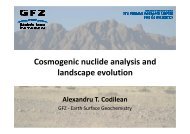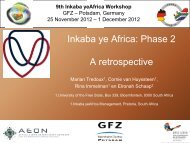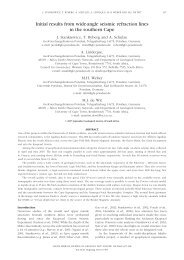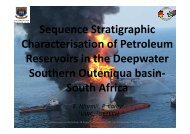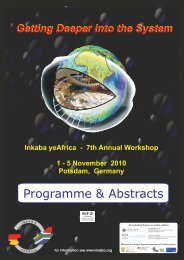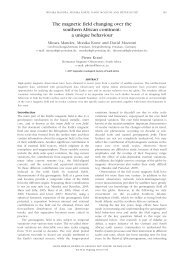South Africa - Inkaba.org
South Africa - Inkaba.org
South Africa - Inkaba.org
You also want an ePaper? Increase the reach of your titles
YUMPU automatically turns print PDFs into web optimized ePapers that Google loves.
The application of facies analysis on sedimentary evolution<br />
and changes in sea-level on the Kookfontein and Waterford<br />
Formation in the Permian Ecca Group, Tanqua, Karoo Basin<br />
R. Arenz¹, D.Mikeš²<br />
1. Stellenbosch University, <strong>South</strong> <strong>Africa</strong>, renitia@gmail.com<br />
2. Stellenbosch University, <strong>South</strong> <strong>Africa</strong>, mikes@sun.ac.za<br />
ABSTRACT<br />
Facies are considered as deposited by a unique set of physical processes which can be interpreted from lithologies,<br />
textures, primary sedimentary structures, fossil content and stratigraphic position. In many cases the observed<br />
sedimentary structures alone are not sufficient to unequivocally assert the mode of deposition and in places comparison<br />
with models described in literature may even be misleading.<br />
The aim if this study was thus to; Analyse the sequence in which the facies occur, providing information about the<br />
facies itself; the relationship between depositional environments and stratigraphic sequences developed through time as<br />
a result of transgressions and regressions. Evaluating controls on sedimentary facies architecture, incorporating facies<br />
analysis and interpretation. Evaluating the use of facies architecture to infer sea-level change. Using facies architecture<br />
to determine depositional setting.<br />
During a month long period of field work Phase 1 in the Tanqua and Laingsburg depocenters, an outcrop field study<br />
was carried out to facilitate compilation of detailed sedimentary logging, and vertical profiles accompanied by outcrop<br />
gamma log data facilitating easy comparison with subsurface data sets for correlation of the Waterford and Kookfontein<br />
formations’ lithologies and radioactive decay properties. Detailed stratigraphic mapping was carried out using a<br />
portable multi-channel scintillation spectrometer, SGR data collected is used as a correlation tool. The spectral gamma<br />
ray (SGR) tool measured the total gamma ray (GR) and the individual contribution from the three major radioactive<br />
sources, namely 40K, 238U and 232Th, in a given time. Data collected will be presented in seconds (sec). The<br />
sedimentary successions were then logged by measuring the gamma radiation at an average vertical spacing of 50 - 75<br />
cm over a selected time interval, namely 180 seconds for the argillaceous units and 240 seconds for sandstone.<br />
Sedimentological and gamma ray profiles were measured from the basin-floor deposits to the base of the deltaic<br />
successions in the Tanqua sub basin. The locations for these profiles were chosen on best outcrop positions for regional<br />
correlation by using arial photographs geological and topographic maps. Samples were collected from fresh outcrop<br />
surfaces where possible, concentrating mudstone sampling between fans/units, and sandstone samples at the start and<br />
end of major depositional facies. Samples were taken at vertical intervals for the purpose of constraining regional<br />
correlations.<br />
Through a collaborative study at Stellenbosch University sedimentology research group, interpretation of facies, based<br />
on spatial relations and internal characteristics (lithology and sedimentary structures) using information from<br />
stratigraphic units and facies subdivision will be used to construct a new facies model for the Kookfontein and<br />
Waterford Formations of the upper Ecca shelf to slope succession in the Tanqua depocentre .<br />
KEYWORDS: Facies architecture ;sea- level change; Kookfontein Formation; Waterford Formation; Tanqua subbasin.<br />
2



